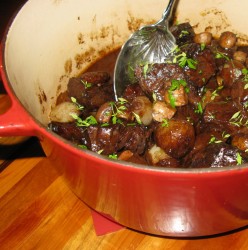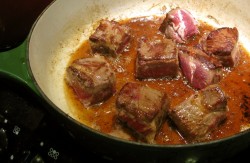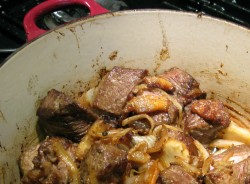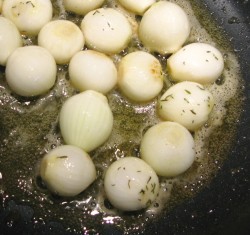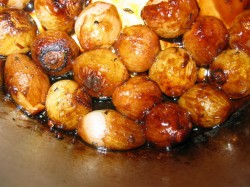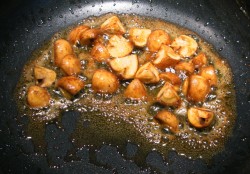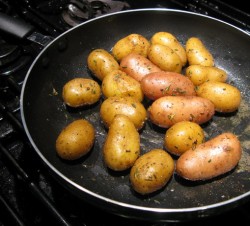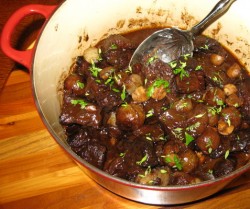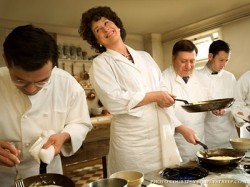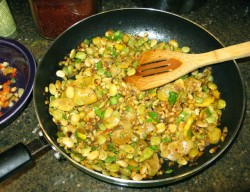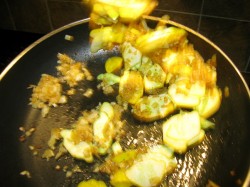Cooking For Others
For me, and it turns out, lots of other folks, cooking is about love.
It really is that simple.
If I didn’t have a family, or roommates or friends, and I didn’t work as a chef or line cook–in other words, if I was completely and utterly alone, I probably wouldn’t cook much that was interesting, and I certainly wouldn’t write a food blog.
Cooking for myself is bloody boring, not to mention a pain in the wazoo–why make that much of a mess just for myself? Especially since it would be myself cleaning up that mess without help or companionship in the kitchen.
So, were it just me, there would be no Beouf Bourguignon, Hillbilly Fried Rice or Panko Fried Catfish. No Chicken with Bitter Melon. No Thai Green Curry. No Bacon-Filled Waffles with Chili-Fried Apples. Nothing that really required multiple steps, lots of oil, large vegetables, hand-made curry pastes, special electric appliances or leftovers.
It isn’t as if I would never cook at all.
I would probably still make simple Indian curries, very simple stir-fried dishes, soups, dals, and easy cold noodles, and quick hot pastas, but falafel would be out of the question.
If it was just me, I would barely bake. Why make cheesecake just for yourself? Or Aphrodite Cakes? Or Aztec Gold Brownies? Or even my beloved sour cherry pie, for goodness sake? No one should eat an entire pie, for various reasons, and if I wasn’t going to eat the entire thing and it was just me, well, then, I would just not bake the pie in the first place.
Luckily, few cooks live in completely isolation. We almost always have someone around for whom to cook and it is a good thing too. Not just for our waistlines, but for our sanity as well.
I fully believe that most people who love to cook, and this includes line cooks and chefs, do so not only because they love food and the challenge of working alchemical arts upon it, but because they love people, and their favored way of showing that love is through feeding them.
Every great chef or cook I have ever known, even the cynical and cranky ones, even the most crusty and snide ones, all have a heart filled with love for other people, and the desire to show that love through the most intimate act of cooking them food which feeds both body and soul. Often all of that cranky, crusty and cynical demeanor is armor which protects those sweet and loving hearts from the slings and arrows that an often rough world flings in a professional kitchen.
Most home cooks I have known are the same way; they will not hesitate to cook for their loved ones, but can’t be bothered to do much more than scrambled eggs or grilled cheese sandwiches for themselves. My Gram, from whom I learned to cook fried chicken and delicious beef vegetable soup, and who taught both my mother and I how to make homemade noodles, as she got older and after Pappa died, barely cooked for herself. I would go to her house on weekends and cook for her, even though I was in the middle of a divorce and was living forty-five minutes away. I did it because I loved her, she was losing much needed body weight and she would delighted eat whatever high-calorie food I would create for her, and would dutifully heat up the leftovers over the week.
After going to see Julie & Julia with me, Heather said that the main reason she is moving into a house filled with young roomates was so she would have someone to cook for. She had already made her reputation as a cook in her office by bringing batches of Aphrodite Cakes and Aztec Gold Brownies to share, but she wants to do more. (And, as she noted on her Facebook page, she now wants to learn French food! Yeah, Julia–still inspirational after all of these years!)
When she said that, Dan, who also went to see it with us, pointed out that Neil Peart, famed drummer for Rush, has a food blog on his website. In the opening essay of the blog, Peart talks about how he learned to cook for his first wife when she was ill, and as such, has come to see cooking as a very visceral expression of love. Left to his own devices, he’d not cook–he doesn’t love it for itself. He loves cooking for the people he loves– and that is a distinction that I believe most people would understand and agree with.
My first guinea pig, I mean, cooking student, Bill, figured it all during the hours of a long evening of the two of us cooking a multi-course Chinese feast at the home of a friend who had never tasted our food before.
It was a stressful evening for Bill–me–I was in my element. When we had gone to Krogers here in Athens (we were visiting from Maryland), I had found that there was no ground pork to be had, so I had shrugged, bought pork shoulder and loin and had declared I would simply mince it by hand with two matched cleavers–mine and Bill’s. This process is loud and flashy, and before long, half of the twenty-odd diners had popped their heads into the smallish kitchen to see what the ruckus was about.
Bill worked quickly and efficiently, but had the air of a wild rabbit harried by hounds–breathless and wide-eyed.
By the time we served the first course, a hot and sour soup fragrant with lemongrass and galangal, Bill’s face had taken on the look of a whitetail deer in the headlights of an eighteen-wheeler on a rainy night. He was terrified.
I whispered in his ear, “Relax. Remember, no apologies, and no fears. Ever.”
When everyone had filed through the kitchen and ladled up their soup, he and I both two small bowls, and slipped into the nearly silent living room.
I say nearly silent because while there was a lot of sipping and noisy slurping going on, no one, but no one was talking.
Everyone’s head was bowed over their bowls as they busily ate the soup in great gulps.
I smiled, sat and sipped my soup, while watching everyone else eat.
When I looked up, Bill was sitting across from me on a floor pillow. He hadn’t touched his soup, even though he hadn’t eaten all day.
He was just gazing around, smiling goofily.
“Now I understand,” he whispered, “Why you barely eat anything when you cook for people. You don’t need to.”
I grinned and rose, heading back to the kitchen after finishing my last swallow of my meager bowl of soup.
When Bill followed me, I nodded. “My food is their delight, not the food I cook.”
As he sipped his soup, I turned back to the stove.
“Let’s get back to work,” I said. “Spring rolls can’t roll and fry themselves, you know.”
Meatless Monday: Vegetarian Arroz Gratinado
I was going to make quesadillas for this week’s meatless recipe, but after eating Boeuf Bourguignon for dinner Friday night and Provencal Roast Chicken (yes, you get a recipe for that this week!) on Saturday, that for Sunday, I absolutely did not want anything fried. Sure, sure, you -could- make quesadillas by baking them, but they don’t taste as good that way!
And yes, refrieds are made by lightly frying mashed beans in olive oil–but I use much less oil in frying beans than I do when frying quesadillas.
So, I had the inspiration of making a vegetarian version of arroz gratinado, the delicious Mexican casserole of rice, salsa and shredded meat covered with melty-gooey-cheesy goodness. My version includes refried beans anyway–so I decided, what if I left out the meat?
And what if I added sauteed kale and chard?
Oooh.
That sounded ever so delightfully tasty to me.
Look, you don’t need a recipe to make this–just do something like what I did.
So, what I did was make a batch of Wholly Vegetarian Refried Beans, and a pot of jasmine rice that I cooked with a mixture of V-8 juice and vegetable stock in my rice cooker (2 cups of jasmine rice with 1 cup of V-8 juice and 1 1/4 cups of vegetable stock go in the rice cooker with a sprinkle of salt and then the lid gets clapped down and the button is pushed and in 45 minutes, we have some nice pinkish rice that has the light flavor of tomatoes and other vegetables), then I simply caramelized two thinly sliced onions with 1 big clove of thinly sliced garlic and then sauteed about a pound of mixed kale and chard. (Here’s a basic approximation of what I did with the kale and chard, minus the mushrooms and truffle oil.)
Then I shredded some sharp cheddar cheese and started layering.
First a spray of some olive oil to keep the goodies from sticking. A smear of about three tablespoons of salsa, (you can use homemade or from a jar–I like Frog Ranch Chipotle if I don’t have homemade on hand) to cover the bottom of the pan, and then a layer of rice that gets packed down a bit. Then beans, a tiny bit of salsa, then greens,a little more salsa and finally, the cheese.
And then, into the 375 degree F. oven it goes for about twenty minutes, or until the cheese is melted, bubbly and browned in a couple of spots, and out it comes. Cilantro gets sprinkled over it and away we go!
I served it with freshly made Calico Salsa and some blue corn tortilla chips on the side.
Some other vegetables you could layer into this casserole would be roasted corn on the cob (cut off the cob, of course!), sauteed summer squashes seasoned with caramelized onions and garlic, roasted tomatoes and red bell peppers, roasted poblano chiles, or sauteed mushrooms.
In Honor Of Julia: Boeuf Bourguignon
You know, I had forgotten how good French food is.
This is because once I got out of culinary school, I can count on one hand how many times I have made French dishes. Oh, yes, I use French technique every day that I enter the kitchen, either at home or in a restaurant, but as for actually making full-on French food–nah, I haven’t done that in years.
Until today.
See, I got all inspired by watching Julie & Julia–all of those porn-worthy shots of delicious looking food got to me and I just -had- to dig out my old dog-eared, butter-stained and battered copy of Mastering the Art of French Cooking and give some recipes a go.
And the first one just had to be Boeuf Bourguignon–not just because it is featured prominently in the film, but because it is one of my favorite French braises. And I hadn’t made it since my first year of culinary school. And I realized that when I was looking at a beautiful pot of it in a red Le Creuset French Oven just like the one that Zak’s Grandma handed down to me, and it was just a shame.
So I had to make it again–and I wanted to use Julia’s recipe and method–just to see how different it was from the version I learned in culinary school.
It was different; in culinary school, I remember tossing the meat with flour and then browning it in rendered bacon fat and olive oil. The meat was then removed, and onions and carrots were browned in the same oil, while scraping up bits of browned flour from the bottom of the pan.
Julia’s recipe calls for the meat to simply by dried with a paper towel and then put into the pan with the nearly bacon fat and oil and browned well on all sides. Then the meat is removed and set aside, and the onions and carrots are browned in the pan. Then the onions and carrots are removed, and the cooking fat is poured out of the pan. Back into the pan goes the beef, bacon lardons, onions, and carrots. At this time, the flour is sprinkled over the meat and it is tossed together so the meat is coated lightly with flour.
Then into the a 450 degree F. oven the pan goes for four minutes. After four minutes, you take the pan out, toss everything around again, and pop it back in for another four minutes and when it comes out, the meat has a kind of crusty crisp coating of browned flour and there are bits of browned flour goodness all over the onions and carrots. The oven got turned down to a nice moderate temperature–325 degrees F.
In to the pot goes the wine–I used Cabernet Sauvignon–a nice dry and robust one I had around–and beef stock or broth, some tomato paste, minced garlic (Julia crushes hers, but I like more garlic flavor, so mine got minced), thyme, a bay leaf and some salt and pepper. Everything got a nice stir, the liquid was brought to a simmer on the stovetop, then the lid was clapped on and into the oven it went, there to cook, pretty well unattended (I did check on it twice) for about three hours.
Now, I ask you–how hard is that, really?
And the technique of sprinkling the flour on -after- the meat is browned–I really like the texture it gave the beef, and I also like the fact that it made a nice thick, smooth sauce by the end of the cooking time with minimal effort from me.
So, for the first two hours that the beef cooked, I went into my sewing room and worked on a quilt. I didn’t need to be in the kitchen, hanging over the stove, waiting for the beef to do its thing. It was fine all on its own. That is the beauty of making a braised dish in an enameled cast iron pot in the oven–you don’t need to hover. It does all the work for you.
So, I waited for the last hour of the cooking time to make the brown braised pearl onions and butter sauteed mushrooms. I had forgotten how simply cooked both of these absolutely fabulous vegetables are, but simple doesn’t mean flavorless. Oh, no–these tasted amazingly good.
The onions are simple–you peel them–easily the most annoying step in the making of this dish. I do it the way I learned at my very first restaurant job–cut a tiny slice off the top and bottom of the onion, and then make a shallow slit from top to bottom that cuts through just the first layer of onion skin and flesh. Then peel that layer off and voila! You have a pretty, shiny pearly onion, all ready to get browned in butter and olive oil, then braised in a bit of wine and beef stock.
When they are done, they are even prettier than they were all shiny and new and white. They are brown and delectable; the liquid they are cooked in reduces to a thick, deeply colored and flavored glaze that coats those dear little alliums in a cloak of sweet, meaty goodness.
I made an extra couple of onions and it was a good thing–because once I tasted one, I had to give on to Brittney to try. But then, maybe if we hadn’ t tasted them in the first place, we would not have tortured ourselves to keep from eating the rest before everything else was done.
So, we contented ourselves with licking the thick syrupy bits of leftover glaze that clung to the sides and bottom of the saucepan.
The mushrooms are simplicity incarnate. You wash them, you dry them and you cut the bottom edge of the stem off. Then you either leave them whole or cut them into quarters–I decided to cut mine up–and you saute them in butter–in small quantities–never crowd your mushrooms in the pan or they will steam instead of saute–and that is it. I did mine in two batches and got the brownest lightly crisped on the edges mushrooms you could ever want.
Boiled potatoes are a traditional side for this dish, so I did whole small Carolas and French Fingerlings boiled in their jackets until done. Then, I drained them and popped them into a saute pan that had melted, bubbling butter in it, and sprinkled them with salt, pepper and minced fresh rosemary and tossed them around over high heat for about five minutes. The butter browned lightly and coated the potatoes in a delicious golden glaze that made them shimmer, flavored with those lovely deep green flecks of rosemary leaves. The rosemary really highlighted the natural nutty flavor and smooth texture of these little potatoes, while not interfering with the sauce from the beef.
Then, I just made a simple green salad with a honey-Dijon vinaigrette, and cut into a baguette, and strained the sauce from the beef–which had attended to itself so perfectly that I didn’t even have to reduce it any farther in order to get it to gently coat the back of a spoon.
And dinner was served.
Now, here are a few caveats–I did take a few shortcuts and made a few tiny changes to Julia’s recipe–mostly having to do with the bacon. I didn’t have bacon that hadn’t already been sliced, though I had some that had been quite thickly sliced, so I used that. And I didn’t blanch the bacon, because I saw no really good reason to do so.
And, when it came time to put the meat back into the pot before pouring the strained sauce over it–I had forgotten to pick the bacon out of the tangled mess of spent onion and carrot corpses and put it back in with the beef, so we ate it sans bacon. But, you know–it still tasted damned fine anyway, so I don’t feel all that bad about it.
And one more thing–here is a tip directly from me, not Julia, about what to do if your perfectly sublime sauce turns out to taste just a little flat. If adding salt and pepper to taste rounds it a bit, but not quite enough–give it a little dash of balsamic vinegar. No really–it will perk up any sauce or gravy that might be just a bit too rich to taste right–the taste will flatten out sometimes. The vinegar rounds it back out and gives it sparkle. I am talking just a little bit–not much–a half teaspoon to a teaspoon at most, and sometimes even less than that. Be sparing!
Looking back on tonight’s dinner, I’m not really sure how or why I forgot how good French food is–but I don’t intend to make that mistake again.
Now I just have to figure out which recipe to turn to next in Julia and Simone Beck’s magnum opus.
Boeuf Bourguignon
Ingredients:
6 ounces thickly sliced bacon cut into 1/2″ wide pieces down the length of the bacon slices
1 tablespoon olive oil
3 pounds fairly lean stewing beef, cut into 2″ cubes (I used half top round and half chuck, well trimmed of fat)
1 large peeled and sliced carrot
1 large sliced onion
1 teaspoon salt
1/2 teaspoon freshly ground black pepper
2 tablespoons all purpose flour
3 cups of full-bodied red wine (I used Cabernet Sauvignon, as I noted earlier)
2-3 cups beef stock or broth
1 tablespoon tomato paste (I use the kind that comes in tubes like toothpaste–so convenient!)
2 large cloves garlic, minced (mine worked out to be about a tablespoon and a half after it was minced–big cloves of garlic!)
1/2 teaspoon thyme
1 bay leaf, crumbled
18 pearl onions, peeled
1 1/2 tablespoons butter
1 1/2 tablespoons olive oil
1/4 cup red wine (from the same bottle as the wine for the beef!)
1/2 cup beef stock or broth
1/2 teaspoon dried thyme
salt and pepper to taste
2 tablespoons butter
1 tablespoon oil
1/2 pound fresh mushrooms, washed, dried and trimmed–if small, leave whole, if larger, quarter
salt and pepper to taste
a tiny amount of balsamic vinegar–if needed*
fresh thyme leaves and chopped fresh parsley leaves for garnish
Method:
Preheat your oven to 450 degrees F.
Heat the first measure of olive oil in a heavy-bottomed skillet over moderate heat. Cook the bacon until it is just starting to brown and is nicely brown, but is not crisp. Remove from skillet and set aside on a plate. Turn the heat up to high and let the oil and rendered bacon fat come nearly to the smoke point.
Dry the cubes of beef well on paper towels–remember if the meat is not dry, it will not make a nice browned crust. Brown it on all sides in the same skillet in which you cooked the bacon. Do it in batches if you have to–don’t crowd the pan or the meat will not brown as nicely.
When the beef is brown all around, remove it and set it aside on the plate with the bacon.
Dump the sliced onion and carrot into the same skillet and sprinkle with the salt and pepper, then cook, stirring, until the onions brown really well–they should be a reddish color, and the carrots are browned at the edges. Scoop the vegetables out with a wire skimmer and put them with the meat. Dump out the cooking oil.
Put the beef, bacon, onions and carrots into a heavy bottomed Dutch oven or deep casserole dish. Sprinkle the flour over everything and toss the meat especially to coat it well.
Pop it uncovered into the oven for exactly four minutes. Take it out and stir it well making sure to turn the meat, and put it back in for another four minutes.
Take it out and turn the oven temperature down to 325 degrees F.
Stir in the wine and enough stock or broth to make sure that the beef cubes are just barely covered. You can have wee bits and corners of the cubes poking out–but you don’t want huge swaths of meat uncovered–you don’t want it to dry out. Stir in the garlic, the tomato paste, the bay leaf and the thyme, then turn the heat on under the pot and bring the liquid to a nice easy simmer.
Clap the lid on the pot and into the oven it goes. Check it now and again to make sure it is simmering, not boiling and that the liquid level is not reducing too quickly. Otherwise, you can leave the pot pretty well undisturbed.
While the beef cooks, prepare the onions: Melt the butter and olive oil measures that come in the list right under the pearl onions in a skillet or wide saucepan. Add the onions, and cook, tossing and stirring and rolling the onions gently around until they are as evenly browned as you can manage–they won’t be perfect because these little rascals just roll back and forth and won’t keep enough to get an even tan.
When they are a nice golden color flecked with some pale white shimmer showing, pour in the wine and stock or broth and add the thyme.
Bring to a simmer over high heat, turn the heat down and cover the saucepan and cook, stirring as needed, until the onions are mostly tender. Remove the lid from the pot and cook, shaking and stirring until the liquid reduces down to nothing more than a shiny deep reddish brown glaze that clings mostly to the onions, but a bit to the pot. Add salt and pepper to taste to the onions, toss them once or twice more to distribute the salt and pepper, and set aside to be added to the beef at the last moment before service.
Once the onions are done–make the mushrooms.
Melt the last measure of butter with the last measure of olive oil in a saute pan. Put half of the mushrooms in the pan, and cook, stirring and tossing, until the mushrooms take on a deep golden hue with lightly crispy browned edges. Pour the cooked mushrooms into the same bowl as the onions and cook the second batch the same way. Set them aside with the pearl onions.
The beef is finished cooking when a fork with easily pierce it and just as easily slide out again. If the beef clings to the fork, even if the fork went in easily, the meat still need to cook some more. But when it is ready, remove the beef from the cooking pot and set it aside with the pearl onions and mushrooms. If you want to go fishing around for the pieces of bacon, by all means, do so, but I didn’t bother and the dish was still fantastic.
Then place a fine sieve over a saucepan and scoop the liquid and remaining solids out of the cooking pot into the sieve. Press the solids against the sieve to remove as much liquid from them as possible–the sauce is thick and will cling to the solids. What I did was ladle the contents of the pot one or two ladlesful at a time into the sieve, and then I was mash and stir the stuff in the sieve against it and let all of the sauce be pushed or drip out, then I would empty the solids from the sieve for the compost bucket, though if I still had dogs, I would have given the solids to them–they would have loved it. Then, I repeated until I had the pot emptied and the sauce all collected.
Then, scrub out your cooking pot, and dry it well. Put the beef, pearl onions and mushrooms into it.
Heat the sauce in the saucepan over medium heat until it simmers. If it is thick enough to lightly coat the back of a spoon, you are golden and have to do very little. If it is too thick, thin it out with a tiny bit of broth–if it is too thin, bring the sauce to a boil and reduce it to the proper thickness. If you defatted your beef and poured out the oil well, you will have very little to no excess fat in the sauce, but if you do, and some comes to the top as you simmer it, skim it off and discard it. You should end up with about two and a half cups of really delicious sauce. Taste your sauce and add salt and pepper as needed–and a tiny dash of balsamic vinegar if it is properly salted and peppered, but still tastes just a little bit flat.
When the sauce is the proper thickness, pour it over the meat and vegetables and give it a nice stir to coat everything, and then sprinkle with the fresh herbs and either keep it warm in its pot–this is why cast iron enameled pots are so great–or serve it right away, with a salad, some boiled potatoes and some good baguette to sop up the sauce.
Julie & Julia Gets People Into the Bookstores…And The Kitchen
Sometimes, I am just all late and wrong.
Last night is the first time my girls and I (my daughter Morganna, the 19 year old line cook, and her best friend Brittney, the 18 year old line cook) could get together and get away to see Nora Ephron’s film, Julie & Julia. Which means, since it opened on August 7th, that I am sure that everyone else in the country, especially food bloggers, have already seen it. (OK, not everyone else has seen it. My dear Aunt Judy hasn’t seen it yet, either–she is going later this week.)
Late and wrong as I am, I still want to write some of my thoughts on the film, because I think that one of the best things that films do is they bring people together to talk about them. (Yeah, I have a minor in film, along with one in history, one in biology and one in women’s studies. Yes, I am a super-geek who would go to college the rest of her life if she could get away with it.)
Unsurprisingly, I really liked the movie, and I love the way that the script was structured, flipping back and forth between Julie Powell’s life as sourced from her blog and later her book, Julie & Julia, and Julia Child’s as remembered in her memoir, My Life In France.
Viewed as a purely structural device, bouncing back and forth between the two women’s lives and marking parallels between them brings a beautiful symmetry to the narrative, and builds a sense of anticipation as the stories unfold. The actors were all superb, and each of them brought an authentic sense of their characters’ humanity and reality to the screen. Even the supporting actors, particularly Linda Edmond who portrayed Simone Beck, were spot-on, their performances sparkling, fresh and genuine. They all brought a strong humanity to the characters which made them very appealing to the viewer, even when the characters’ personalities were not ones which would normally appeal to the viewer.
Here is where I tread in dangerous waters as a food blogger. It seems that any criticism of Julie Powell as a writer or as a person portrayed in this film or in her memoir, especially when written or uttered by a food blogger, is viewed as a sign of jealousy or personal attacks by herself and her fans. This is a shame, because the fact is, Julie Powell put herself out there in public view–she wrote her blog and wrote her book in a way which she can easily be viewed as narcissistic and shallow by readers–so if there are some who look at her work and declare their honest opinion of it, it doesn’t mean that they are attacking her personally. It means that they read her words and her own portrayal of herself and had an opinion about them–an opinion which may not be positive.
And that is okay. As a food blogger and a chef, I have taken plenty of flak for things I have written, and have gotten personal attacks which may or may not have been warranted. It comes with the territory of writing for the public. If you write strong opinions on issues, you are going to step on some toes, and you are going to hear about it from readers. And yeah, some of them are going to get personal, because frankly, some people take what you write personally, (even if it isn’t personal) and respond in kind.
It is just something that you should expect.
And really, if you write about yourself, as in a blog or memoir, you as the author are the one who is making it personal. And the fact is–not everyone who reads about someone is going to like them as a person. It is just how it is. Not everyone is equally loved by the rest of the world, because different people get along with different personalities, period. End of sentence, paragraph and story.
So, knowing this, I am just going to say the bad thing that food bloggers have to be very politic and not say: I did not care for either Julie Powell’s blog, nor especially, her book.
There. I said it.
And if readers want to see it as sour grapes or jealousy, so be it, but the truth is, I found Julie’s writing to be very shallow and her story to not be all that compelling. Her idea of cooking every recipe in Julia Child’s Mastering the Art of French Cooking was a stroke of genius, and as a blog subject it was perfect. It still stands as one of the best thematic hooks in the history of food blogging. I bow to Powell when it comes to the narrow focus and time limitation on her blog, especially since I have never been able to narrow down what I want to write about in my own blog. (I am just too damned interested in too damned many topics to impose limitations on Tigers & Strawberries.)
It is just the execution that I found lacking–I just didn’t like her writing style.
And that is fine. I don’t have to. Lots of people love the way she writes and what she writes about and I am happy for them and for Powell.
Now that I have said the dangerous thing, I can get on with what I wanted to say about the film. Amy Adams’ portrayal and the script make Julie Powell a much more interesting and sympathetic character than Powell does herself in her own writings, and that is a good thing. However, her story is just not as compelling or interesting as the story of Julia Child in postwar Paris, and that is the film’s greatest flaw. The two tales, while superficially similar, are not that analogous, and while presenting them equally in the structure of the film provides a sense of symmetry, the overall effect is not symmetrical.
Even though I liked Amy Adam’s portrayal, I found myself growing impatient during the segments that showed Powell’s struggles to complete her self-appointed mission. I wanted to go back to France, or Germany or Norway–wherever Julia and Paul had been stationed, and see what was happening there, because it was just more interesting to me. Like many reviewers, I feel that it was a shame that My Life in France wasn’t given its own film treatment, because it is just that more fascinating to the viewer.
(Let me add that one of the most interesting sociological contrasts between 2002 Queens and 1950’s Paris was the amount of cigarette smoking that was going on in the 50’s. Everyone smoked. Everywhere. In restaurants, in restrooms, at home–everywhere. And, while I am at it, I must applaud Nora Ephron’s eye for detail–the costumes, hairstyles, make-up, props, sets and street shots of Paris were period-perfect and really drew the viewer into that world.)
But, flawed as it was, in truth Julie & Julia has had one great effect on me: it made me want to crack open my ages old copy of Mastering the Art of French Cooking, get in my kitchen and whip up some Boeuf Bourguignon, a dish I haven’t made since culinary school.
And it seems that I am not the only one who wants to revisit the classic tome: The New York Times reports that for the first time since it first came out, Mastering is once more at the top of the best-seller list, as it rides on the coattails of the movie that it partially inspired. Nearly fifty years after its publication, it is once again flying off of the shelves (along with everything else in print by Julia Child, including her memoir, as well as Julie Powell’s book) and hopefully into kitchens across the country.
Many readers, however, seem to be stunned by the amount of fat involved in these recipes, and many are adapting them to lower the fat content, while hopefully retaining the flavor. One reader quoted in the Times article who made what she called “beef fauxguignon”–great name, by the way–admitted to using a can of cream of mushroom soup, a can of burgundy wine and a can of cream of French onion soup seems to have missed the point in lowering the calories–cream of mushroom soup is anything but low-calorie. When she said, “Yes, Julia Child rolled over in her grave when I opened the cream of mushroom soup, I’m pretty sure of that. But you know what? That’s our world.†I had to laugh. The truth is, the opening a can of this and a can of that and popping some wine in the pot isn’t just our world–it was the world of 1950’s American cooking that Julia Child set out to change in the 1960’s too.
The irony is delicious.
But, when all is said and done, I think that we cannot dismiss the fact of Julia Child’s lasting impact on the eating habits and cooking abilities of Americans, nor can we downplay the effect that this film will have upon a new generation of American cooks.
By getting people who were only tangentially aware of Julia Child as a pop-culture icon out of the theatre and into the bookstore and then, hopefully, their kitchens, we also cannot dismiss the fact that by writing her blog, and then her book, and by selling the film rights to that book, Julie Powell helped remind America of why we loved Julia Child in the first place.
Meatless Monday: Three Sisters Succotash
Succotash is one of those dishes that sounds like a joke. You know, like when Sylvester says, “Thsufferin’ thsuccotasth.” It just doesn’t sound like anything that anyone would really eat.
But yes, people do eat it and it is very good.
But where did it get that outlandish name?
It isn’t outlandish at all–I mean really, we European descendant’s languages are the ones that are outlandish to this continent if you look at it from a historical perspective. Succotash, which is a Native American dish, came from the Narragansett word, “msÃckquatash,” which means, “boiled corn.” But it doesn’t denote just boiled corn–it is corn and lima beans, another native food, boiled together. (Often boiled together in a tightly woven basket–one that is so finely wrought that it could hold water. Of course, because baskets cannot survive the direct heat of the fire, the food was cooked by heating clean stones in a fire until they were red-hot. Then, using tongs, the stones were lifted and dropped in the basket which was filled with water, corn and beans. When the stones cooled too much to heat the water, they were fished out and new ones were dropped in. Ingenious, yes?)
The original dish was seasoned with sea salt, and fat rendered from a bear or beaver, but after the Europeans came and brought pigs to the New World, Native Americans began using salt pork or bacon to season the dish. I have seen versions of the recipe that use wild onions and ramps to season the vegetables as well. When settlers took up cooking it, bacon or salt pork were almost universally used in the pot, often with some onions.
Later, during the Depression, when succotash went from being a historical traditional dish at Thanksgiving to being a staple food (because it was a meatless or mostly meatless dish made of inexpensive ingredients that were filling, tasty and nutritious) bell peppers and tomatoes were often added to the recipe.
My Grandma made succotash all the time, as did my Mom and I like it, but I think that was because they both cooked it with a generous dollup of bacon drippings in it. Bacon makes anything good. I am convinced that you could put it on nearly anything and turn it into a revelation, that is, if you are not inclined toward vegetarianism, are Muslim or a Jew who keeps kosher. Then, bacon isn’t so much of an attraction, but to the rest of us–it is nearly irresistible.
But, if I am going to present a vegetarian version of succotash and I want it to still be full flavored as if it were cooked with bacon–I don’t want it to be a pale, pallid, boring combination of beans and corn.
So, this version, which is sauteed in olive oil and simmered in vegetable stock, is flavored with deeply caramelized onions, garlic, sweet and hot peppers, cumin and smoked Spanish paprika.
I also added baby pattypan squash–the third in the triumvirate of staple foods among the agriculturally based northeastern Native Americans which were poetically called, “The Three Sisters.” Corn, squash and climbing beans were planted together in small plots close to villages in forest clearings; the corn rose tall like great green columns, with beans twining up their stalks, while the squash vines sprawled on the ground, shading the roots of both the beans and corn and also shading the soil enough that weed seeds could not germinate. The roots of the bean plants, furthermore, fixed nitrogen from the atmosphere into the soil–a nutrient which corn takes up from the soil in abundance. This interdependent system of agriculture is now called companion planting.
Not only do the Three Sisters benefit from being grown together, I think they benefit from being cooked together. If you do it right and don’t just boil everything to mush without any other flavoring. All three vegetables are sweet, but with different aromas and textures, so they work together perfectly.
Now we come to the drawback of succotash–shelling the lima beans.
You can cheat and use frozen limas, but I prefer the flavor of locally grown fresh limas. But, that means I need to shell the critters, and after years of shelling bushel after bushel of them at Grandma’s farm so she could freeze them–well, let’s just say my thumbs are still traumatized.
See, lima bean pods are really, really tough and leathery. You can’t just pop off the ends and peel back the string and have the pod pop open the way it will do with green beans. Oh, no, that would be too simple. The way we used to shell them when I was a kid was the adults would use a penknife to cut the end off the pod and then pull the string down. Then, their thumbs would scrape the beans into baskets and pots to be blanched and packed into plastic bags and sealed before being stacked in the freezer.
Until I was about eight or nine, I was only allowed to tear the bean pods off of the uprooted plants that lay in the center of our circle. These I would toss into the laps of the adults which were spread with dishtowels, where piles of pods had already been deposited. At each adult’s feet were baskets and pots to hold the beans. When those filled, I carried them and emptied the pretty pale green and creamy white beans into the huge speckled black enamel pot next to Grandma’s rocking chair.
Then, I would take the empty pods and load them and the uprooted and denuded plants into a bushel basket which I would drag to the cow pasture and empty there so the cows could eat their fill of the fresh green goodness. When we had hogs, I would take a basket’s worth to them, too, and chickens got an armload of the plants–chickens really love the taste of legumes like clover, bean plants and pea shoots.
When I was either eight or nine–I can’t remember which–I was allowed to use my brand new pocketknife to actually shell beans like everyone else while a younger cousin got my old job.
I liked the old job better. Even using a knife, the lima bean pods eventually caused blisters to rise on your thumb and made your joints ache. When Mom, Uncle John and Grandpa complained about how bad lima beans are, they were not bloody well kidding–they are beans that really make you work to obtain the delicious calories they contain!
Now, the truth is, shelling enough lima beans for dinner isn’t bad. They don’t raise blisters until you have done about a half bushel or so. And now that I have grown up and have really strong hands, I have come up with a new method of opening lima pods that doesn’t include a knife. I guess this would only work with really strong hands–try it and see if it works for you.
Hold the lima bean pod like I am in the photo above, on edge, and press down with your thumb really hard on the top edge. Usually, it will pop open at the top and you can pry the pod open the rest of the way and scrape the beans out with pretty minimal effort and no real danger of stabbing yourself in the thumb with a small, sharp knife. (Yeah, I did that when I was a kid.)
Kat helped me scrape the beans from the pods, and when we were done, she carried the pot of pods to the kitchen and down the front steps where we tossed them into the woods for the deer to eat.
I do wish we had cows, goats and chickens to eat them instead, but the City of Athens frowns the keeping of livestock in city limits.
But I can dream, can’t I?
Anyway, here is my way of making succotash–and it isn’t long suffering at all.
You can eat it as is with a batch of cornbread and a salad for dinner, or you can use it to fill enchiladas or tamales.
Three Sisters Succotash
Ingredients:
3 tablespoons olive oil
1 cup finely diced onions
1 teaspoon salt
2 tablespoons fresh, minced garlic
2 tablespoons finely diced sweet bell pepper (red is best, but orange or yellow are good, too.)
minced fresh chili (optional)
1 cup thinly sliced baby summer squash (the younger squashes have less water and more flavor)
1/2 teaspoon ground cumin
1 teaspoon Aleppo pepper flakes (optional)
1 teaspoon smoked Spanish paprika
2-3 cobs of either fresh or leftover grilled corn on the cob, kernels cut off
2 1/2 cups fresh, shelled lima beans
1-2 cups vegetable stock or broth
salt and pepper to taste
1/2 cup finely chopped cilantro leaves
2 tablespoons finely diced sweet bell pepper for garnish (it is really pretty if you can use different colors)
Method:
Heat the olive oil in a saute pan for about thirty seconds. Add the onion and sprinkle them with salt. Cook, stirring, until the onions are a nice dark golden color. Add the garlic, bell pepper and chili (if you are using it) and cook for another couple of minutes, until everything is fragrant.
Add the squash slices and cook, stirring, until the squash takes on some golden color. Add the spices–cumin, Aleppo pepper and paprika, and the corn, and cook, stirring for another minute or two.
Add the beans and cook, stirring for a minute, just to get some of the caramelized flavor into the beans.
Then, add the vegetable stock or broth and turn down the heat. Cover and simmer until the beans are as tender as you want them–I like them fully tender for this dish. When they are done, open the lid and boil off most of the liquid, leaving only the caramelized goodness of the vegetables, all of which will have taken on a golden brownish hue.
Add salt and pepper to taste and stir in the cilantro leaves and the fresh, uncooked bell pepper.
Serve immediately.
Powered by WordPress. Graphics by Zak Kramer.
Design update by Daniel Trout.
Entries and comments feeds.


